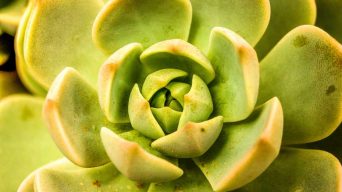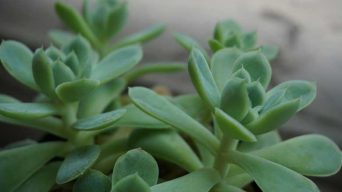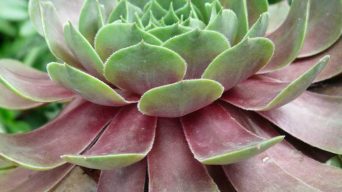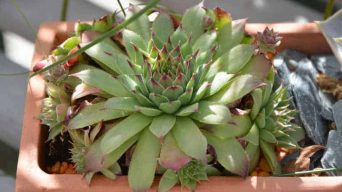Succulents are beautiful plants that require very little care. They can be great for busy people or don’t have time to worry about watering the plants regularly.
They’re perfect for people who want to add a little bit of life to their décor without having to worry about too much upkeep.
But even though succulents are low-maintenance plants, that doesn’t mean they can’t suffer from problems now and then.
One common issue that succulent owners face is when their plants turn purple.
So what causes succulents to turn purple, and more importantly, how can you fix it?
Why Do Succulents Change Colors?
Succulents change colors when they suffer from some kind of stress. By stress, we mean anything that makes the succulent uncomfortable.
Some of the most common causes of stress that lead to succulent color changes are:
- Watering too much or too little
- Too much or too little sunlight
- Temperature extremes (either hot or cold)
- Being moved from one place to another
- Bugs or pests
What Makes the Color Change in Succulents Happen
Succulents have chlorophyll which gives them their green color. Chlorophyll is the substance in plants that makes photosynthesis possible.
Photosynthesis means “making food with light”.
The green color comes from chlorophyll, and red, yellow, and blue colors come from other pigments called carotenoids and anthocyanins.
When chlorophyll is present in large amounts, it causes a green color to be seen by the eye.
If there are fewer or no chlorophyll molecules (as well as carotenoids and anthocyanins), then your succulent will not look green anymore!
Instead, you’ll see some other color related to the absence of chlorophyll.
However, this doesn’t mean that your succulent is not healthy!
Not All Color Changes in Succulents Are Cause for Concern
Some types of succulents are naturally purple, red, or yellow. In fact, there are even succulents that look blue or pink!
Since the chlorophyll content of your succulent is not high enough to make it green anymore, these colors become visible instead.
These color changes occur naturally and don’t mean anything wrong (or good) about the plant itself.
Many people mistake color changes for a sign that their plant has been damaged.
However, this isn’t always the case. In many cases, it’s perfectly natural, and there are no health problems at all with the plant.
Succulents can change colors because they are growing. For example, they may also look different in the winter than they do when it’s summer.
What’s important is that the plant can still photosynthesize and grow, even if it doesn’t look green anymore.
As long as your succulent gets all the nutrients needed for growth (light, water, etc.), you shouldn’t worry about its color changing!
If a change of color happens to be caused by something terrible, like pests or a lack of water, then there are things you can do to fix the problem and get your succulent back to its healthy color again!
Succulents that have been stressed will start to recover just as soon as their stress has passed and conditions improve again for them.
But is essential to know when a color change can be a sign that something is wrong with your succulent and that you should take action to fix it.
In most cases, succulents will change colors because of something simple like too much sun or water. If you can identify the cause and make some adjustments, your succulent should return to its normal color in no time!
But if the problem is more serious, like a bug infestation, you’ll need to take some extra steps to get rid of the pests and then fix any damage they did.
Why Do Succulents Turn Purple?
So, why is my succulent turning purple?
When a succulent is stressed, it shows up in the color of your plant. It’s easy to see that something isn’t right because you can tell by its unnatural purple hue!
But what are the causes of succulent stress, and how can you fix it if your plant displays this symptom?
Below are some of the most common causes of stress that lead to a succulent turning purple:
1) Overwatering
An overwatered succulent will often turn a deep purple as the waterlogged soil prevents the plant from getting enough oxygen.
Signs of overwatering include soggy, blackened soil and drooping leaves.
If your succulent plant shows signs of overwatering, you’ll need to cut back on watering and allow the soil to dry out completely before watering again.
2) Underwatering
A succulent not receiving enough water will turn a lighter shade of purple as the soil becomes too dry for photosynthesis.
Signs that your succulent is underwatered include drooping leaves, dull or wrinkled foliage, and brown spots on the surface of its soil.
If you suspect that your plant may be underwater, then it’s time to water thoroughly.
Be sure to water succulents until the soil is damp but not wet, and then wait a few days before watering again.
3) Temperature Fluctuations
Temperature fluctuations can cause your succulents to turn purple.
A sudden drop in temperature may shock the plant, and it will show up as a lighter shade of purple on succulent leaves.
On the other hand, if you place your plants outside for too long during hot summer days or leave them there after sunset (when temperatures are no longer warm enough), they may turn purple from the heat stress.
To avoid temperature fluctuations, keep your succulents in a temperate environment with moderate temperatures and humidity levels.
If you suspect that your succulent is turning purple because of temperature fluctuations, then take steps to regulate the temperature in its environment.
For example, if it’s too cold outside, bring your plant inside. If it’s too hot, move it to a cooler location.
4) Overexposure to Sunlight
Succulents don’t need much sunlight to grow, but they require light to create food through photosynthesis.
If your succulent gets too much sun exposure, it may start turning a lighter shade of purple as the excess lighting causes stress on its leaves and stems.
If you suspect that your plant is getting too much sunlight exposure, move it to a shadier location where it will get the amount of light right for its growth and development.
Most succulent plants thrive in indirect bright light rather than direct sunlight.
Remember not to expose your succulents directly under the sun for an extended period.
Don’t expose your succulents for more than a few hours to direct sun in the morning or afternoon.
5) Poor Soil Quality
Poor soil quality can also cause your succulents to turn purple.
If the soil is too heavy or soggy, it prevents your plant from getting sufficient oxygen, leading to stress.
If you think your succulent might turn purple because of poor-quality soil, then repot it into a new container with fresh potting mix and see if this helps stop its discoloration.
You can also try to improve the quality of your soil by mixing in a few amendments, such as perlite or sand.
6) Excessive Fertilization
Fertilizing your succulent too often can also lead to stress and cause it to turn purple.
Over-fertilization can overload the plant with nutrients, showing up as a purplish hue on its leaves.
If you’re fertilizing your succulents more than once a month, you’re probably doing too much.
Try reducing the frequency of your fertilization, only fertilize during the growing season, and use a balanced liquid fertilizer diluted to half-strength.
In addition to causing your succulents to turn purple, excessive fertilization can also cause succulents leaves to fall off and weaken their growth, as well as produce small or weak flowers.
7) Fungal Infection
If your succulents are turning purple, it could indicate that they have a fungal infection.
Fungal infections usually appear as spots or patches on the surface of your plant’s leaves and stems.
If you think that your succulent has a fungal infection, then take steps to treat it immediately.
Remove any infected leaves and stems, and spray your plant with a fungicide. Make sure to follow the instructions on the fungicide label carefully.
Preventing succulents from getting fungal infections is difficult, but you can do a few things to help reduce the chances of them becoming infected.
One way is to ensure that your plants have good air circulation and plenty of sunlight.
Succulents are more susceptible to fungal infections if kept in a humid environment with low airflow and little light.
Keep your plants away from moisture sources such as windowsills when the weather is cool, rainy, or foggy outside, so that excess water doesn’t condense on their leaves and stems.
8) Root Rot
Your succulents might also be turning purple because they have root rot.
Excessive watering and inadequate drainage are the usual culprits behind root rot, resulting in a gradual decline in the health of your plant’s root system.
If you think your succulent might have root rot, take it out of its pot and check the condition of its roots.
If they’re brown or black, soft, mushy, and smelly, then there’s a good chance that your plant has root rot and needs to be treated right away.
To treat root rot, remove the plant from its container, trim off any dead roots, and repot it in a pot with fresh potting mix.
Ensure that the pot has drainage holes so that the soil can dry out between waterings.
You can also try using a fungicide to treat root rot, but it’s generally easier to treat succulent root rot by simply repotting the plant and improving its drainage.
9) Sudden Changes in Growing Conditions
If your succulent is turning purple, it could be due to sudden changes in its growing conditions.
In particular, changing the amount of light or water that your plant receives can cause stress and turn its leaves purplish-blue.
The color change will usually occur on the plant parts that are receiving less sunlight or drought during a particular period.
If you’ve recently changed the amount of light or water your succulent is receiving, then try to gradually adjust its growing conditions instead of making significant changes all at once.
For example, if you’re moving your plant from a sunny window to a spot that’s shaded during part of the day, then slowly move it over a period of days.
Watering your succulents more or less than usual can also cause them to turn purple.
If you’re unsure about how much water your succulent needs, then wait until the top of the soil feels dry before watering it again.
Succulents don’t like to be constantly wet, so make sure that the pot has good drainage and isn’t sitting in water.
10) Nutrition Deficiencies
Lastly, succulents can also turn purple if they lack certain nutrients.
Nutrition deficiencies are most common when succulents are grown in soil that lacks the right balance of minerals.
This can cause the plant’s leaves to become pale, yellow, or brown.
If you think that your succulent might be deficient in nutrients, you can give it nutrient-rich water or liquid fertilizer.
You can also try to improve the quality of your soil by adding organic matter to it in the form of compost, manure, or mulch.
Succulents (and most plants) thrive when they’re given the right balance of light, water, and nutrients.
By keeping an eye on your plant’s growing conditions and correcting any problems that you might see, you can help ensure its long-term health and keep it looking beautiful!
Final Thoughts
Succulents are a great addition to any home and make perfect houseplants.
Not only do they add color and life to a room, but they’re also easy to care for and don’t require a lot of maintenance.
However, even succulents can get sick or stressed from time to time and may start turning purple.
If your succulent is turning purple, don’t panic! There are many possible causes, and most of them can be treated relatively easily.
By keeping an eye on your plant’s growing conditions and correcting any problems that you might see, you can help ensure its long-term health and keep it looking beautiful!







